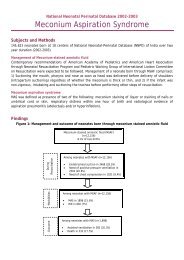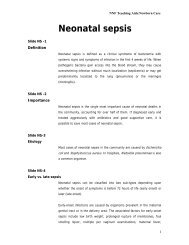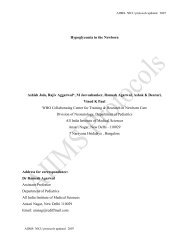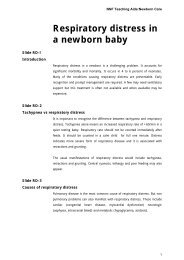Feeding of Low Birth weight Infants - New Born Baby
Feeding of Low Birth weight Infants - New Born Baby
Feeding of Low Birth weight Infants - New Born Baby
You also want an ePaper? Increase the reach of your titles
YUMPU automatically turns print PDFs into web optimized ePapers that Google loves.
AIIMS- NICU protocols 2008<br />
infants need multi-nutrient supplementation till they reach term gestation (40 weeks postmenstrual age). After this<br />
period, their requirements are similar to those infants with birth <strong>weight</strong>s <strong>of</strong> 1500-2499 grams.<br />
Multi-nutrient supplementation can be ensured by one <strong>of</strong> the following methods:<br />
1. Supplementing individual nutrients – e.g., calcium, phosphorus, vitamins, etc.<br />
2. By fortification <strong>of</strong> expressed breast milk:<br />
a. Fortification with human milk fortifiers (HMF)<br />
b. Fortification with preterm formula<br />
Table 3 Recommended Dietary Allowance in Preterm VLBW infants and the Estimated Intakes with<br />
Fortified/unfortified Human Milk<br />
RDA*<br />
At daily intake <strong>of</strong> 180 mL/kg<br />
(Units/kg/day)<br />
Only expressed<br />
breast milk #<br />
EBM fortified with EBM fortified with Preterm<br />
Lactodex-HMF<br />
(4g/100mL)<br />
formula (4g/100mL)<br />
Energy (kcal) 105-130 117 144 153<br />
Protein (g) 3.5-4.0 2.46 3.2 3.4<br />
Carbohydrates (g) 10-14 11.6 16.84 15.58<br />
Fat (g) 5.4-7.2 6.8 7.1 9.06<br />
Calcium (mg) 210 43.2 223 103<br />
Phosphorus (mg) 110 22.2 112 52<br />
Vitamin A (IU) 90-270 680 3308 980<br />
Vitamin D (IU/day) 400 3.5 903 40<br />
Vitamin E (IU) >1.3 1.9 6.3 3.6<br />
Vitamin B1 (mcg) > 48 36.2 79.4 231<br />
Vitamin B2 (mcg) > 72 84.2 156.2 564.2<br />
Vitamin B6 (mcg) > 42 25.7 115.7 221<br />
Folic acid (mcg) 39.6 6 150 36<br />
Zinc (mg) >0.6 0.6 0.96 0.96<br />
Remarks Deficient in protein, calcium,<br />
phosphorus, and vitamins<br />
B1, B6 and D; Zinc content<br />
is slightly less than the RDA<br />
* AAPCON 2004 15<br />
# Based on preterm mature milk<br />
(RDA, recommended dietary allowance; EBM, expressed breast milk)<br />
Deficient in protein Deficient in calcium, phosphorus,<br />
vitamin D, and folic acid; protein<br />
is slightly less.<br />
Supplementing breast milk with minerals and vitamins: The following nutrients have to be added to the<br />
expressed breast milk to meet the VLBW infants’ high requirements:<br />
1. Calcium a and phosphorus a (140-160 mg/kg/d & 70-80 mg/kg/d respectively for infants on EBM)<br />
2. Vitamin D b (400 IU/day), vitamin B complex and zinc b (about 0.5mg/day) – usually in the form <strong>of</strong><br />
multivitamin drops<br />
a E.g. Syr. Ostocalcium (GlaxoSmithKline Co.), Syr. Ossopan-D (TTK Healthcare)<br />
b E.g. Dexvita drops (Tridoss Co.), Visyneral-zinc drops (Lifeon Co.), Dexvita drops (Tridoss Co.)<br />
Downloaded from www.newbornwhocc.org 12








